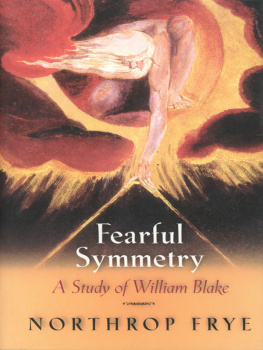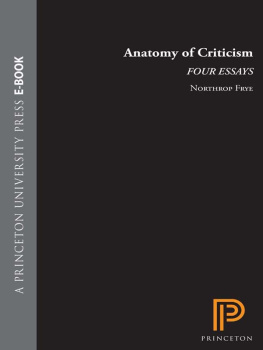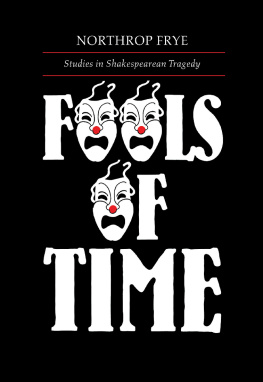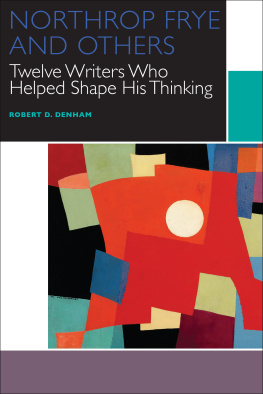Collected Works of Northrop Frye
VOLUME 20
Northrop Fryes Notebooks
on Renaissance Literature
The Collected Edition of the Works of Northrop Frye has been planned and is being directed by an editorial committee under the aegis of Victoria University, through its Northrop Frye Centre. The purpose of the edition is to make available authoritative texts of both published and unpublished works, based on an analysis and comparison of all available materials, and supported by scholarly apparatus, including annotation and introductions. The Northrop Frye Centre gratefully acknowledges financial support, through McMaster University, from the Michael G. DeGroote family.
Editorial Committee
General Editor
Alvin A. Lee
Associate Editor
Jean OGrady
Editors
Joseph Adamson
Robert D. Denham
Michael Dolzani
AC. Hamilton
David Staines
Advisers
Robert Brandeis
Paul Gooch
Eva Kushner
Jane Millgate
Ron Schoeffel
Clara Thomas
Jane Widdicombe
Northrop Fryes Notebooks on Renaissance Literature
VOLUME 20
Edited by Michael Dolzani
Victoria University, University of Toronto and Michael Dolzani
(preface, introduction, annotation) 2006
Printed in Canada
ISBN -10: 0-8020-9179-2
ISBN -13: 978-0-8020-9179-6
Printed on acid-free paper
Library and Archives Canada Cataloguing in Publication
Frye, Northrop, 19121991
Northrop Fryes notebooks on Renaissance literature / Northrop Frye; edited
by Michael Dolzani.
(Collected works of Northrop Frye; v. 20)
Includes bibliographical references and index.
ISBN -10: 0-8020-9179-2 ISBN -13: 978-0-8020-9179-6
1. English literature Early modern, 15001700 History and criticisim.
2. Spenser, Edmund, 155271599 Criticism and interpretation.
3. Shakespeare, William, 15641616 Criticism and interpretation
1. Frye, Northrop, 19121991 Notebooks, Sketches, etc. I. Dolzani, Michael, 1951
II. Title. III. Series.
PR 421. F 79 2006 820.9003 C 2006-902775-7
This volume has been published with the assistance of a grant from Victoria University.
University of Toronto Press acknowledges the financial assistance to its publishing program of the Canada Council for the Arts and the Ontario Arts Council.
University of Toronto Press acknowledges the financial support for its publishing activities of the Government of Canada through the Book Publishing Industry Development Program (BPIDP).
To the memory of my father, Robert Dolzani,
to my mother, Wanda Dolzani,
and to my brother,
Jeffrey Dolzani
Contents
Preface
Among Northrop Fryes papers at Victoria University Library in the University of Toronto are seventy-six holograph notebooks and uncounted pages of typed notes on various subjects. Six notebooks and five sets of typed notes on subjects related to Renaissance literature are collected into the present volume, and have been divided into three categories: those on Spenser, and more widely on the epic tradition; those on Shakespearean drama, and more widely on the dramatic tradition from Old Comedy to the masque; and those on lyric poetry and nonfiction prose. This reflects the organization of a three-volume study that Frye proposed in 1949 to the Guggenheim Foundation. Frye received a Guggenheim fellowship, but never wrote the book. Nevertheless, his application, part of which is also included here, is an important document because it reveals the outlines of his thinking about literature, and about his plans for his own future creative life, in the crucial period, beginning around 1946, between the completion of Fearful Symmetry and his absorption in the writing of Anatomy of Criticism from the early 1950s.
During that time, Frye thought in terms of a so-called ogdoad, a magnum opus of eight volumes that were to be not merely literary criticism but a synthesis of modern thought. The possibility of such a vastly ambitious project was probably the source of his excitement at reading Spengler in the early 1930s. Plans for the ogdoad were set aside during the writing of Fearful Symmetry, but taken up again in the late 1940s, and are in fact reflected by the Guggenheim application. The first three volumes of the ogdoad were to be concerned, respectively, with epic and its relationship to myth and scripture; with drama; and with a theory of literary meaning, by way of a study of prose forms. In other words, the Guggenheim application was really a proposal to compose the first three volumes of the ogdoad. These would amount to a complete study of literature up to about 1600; a concluding fourth volume (the ogdoad was really a double tetralogy) would study the breakdown, since the Romantic era, of the cultural and literary synthesis that culminated in the Renaissance and Reformation. The notebooks towards that fourth volume are contained in the first part of Northrop Fryes Notebooks on Romance, which thus forms a complement to the present volume. The short books on Shakespeare, based on lecture series, that Frye produced from the 1960s onward no longer reflect the ogdoad project directly, but are still in its spirit and were often considered trial runs for its second volume. Thus, while readers may read the following notebooks and notes for their incidental insights, or to follow Fryes struggle to clarify the focus of some of his published works, their greatest reward may be to gain a sense of what is most central to Frye: not, as is usually thought, a vision of literature as a static and unchanging total structure, but a vision of historical evolution and metamorphosis.
Speaking of history, the notebooks and typed notes have a complex one of their own, a history that has been told so often that I cannot repeat it here. As usual, I refer anyone interested to two works by Robert D. Denham: his Preface to Northrop Fryes Late Notebooks, 19821990: Architecture of the Spiritual World (CW, 56) and his The Frye Papers. Also as usual, I assure readers that no arcane numerology is involved in the numbering of the notebooks and typed notes, which is based on a combination of date of accession and location in the Northrop Frye Fonds, not on chronology or subject matter or anything that might actually mean something to the ordinary reader.
The volumes editorial principles are those of previous volumes of notebooks and typed notes, in which Robert Denham and I have tried to reproduce what Frye actually wrote or typed, without the kind of makeover involved in publishers conventions. Fryes shifting between British and American spellings has been preserved; so have his inconsistencies of capitalizing, underlining, and accentuation (or lack of it). However, his underlining has been changed to italics, and his square brackets to braces, in order to distinguish the latter from editors interpolations; his commas and periods have been regularly pinned inside of his quotation marks. A few typos and other obvious slips have been silently emended. A question mark in square brackets in a holograph transcription is a confession of editorial failure to decipher the particular squiggle, scrawl, blot, or blur that occurs at that point in the manuscript. I have added the paragraph numbers, provided first names when useful, and added brief source information such as King Lear, 3.2.458 or Genesis 11. While many of Fryes abbreviations have been expanded, some occur so often that it seemed more reasonable and less distracting to include them in a list at the front of the book; a second list gives Fryes abbreviations, used throughout his career, for the titles of Shakespeares plays and poems.
Next page








